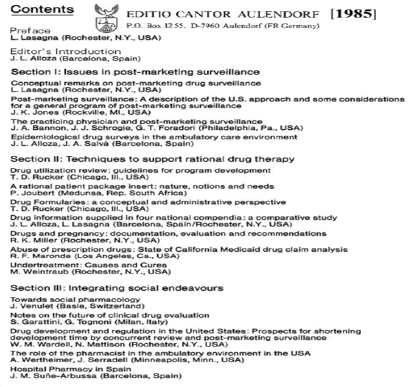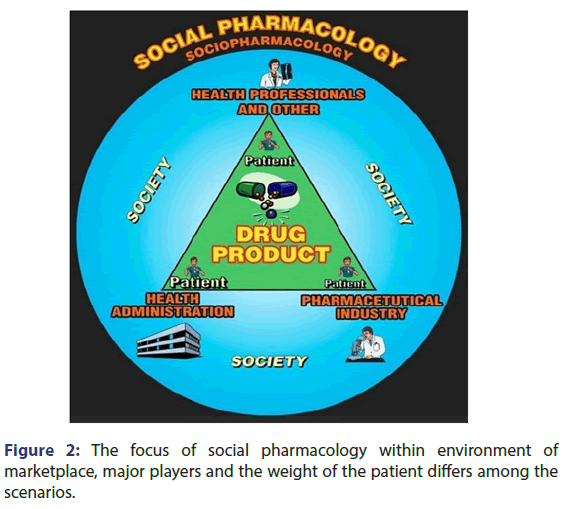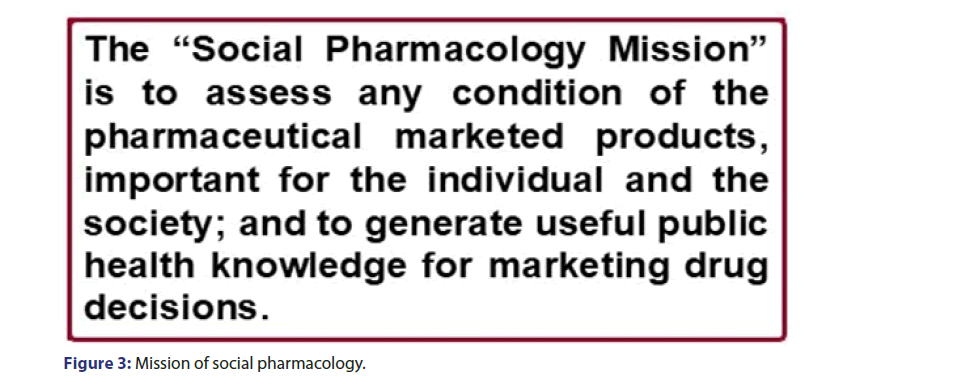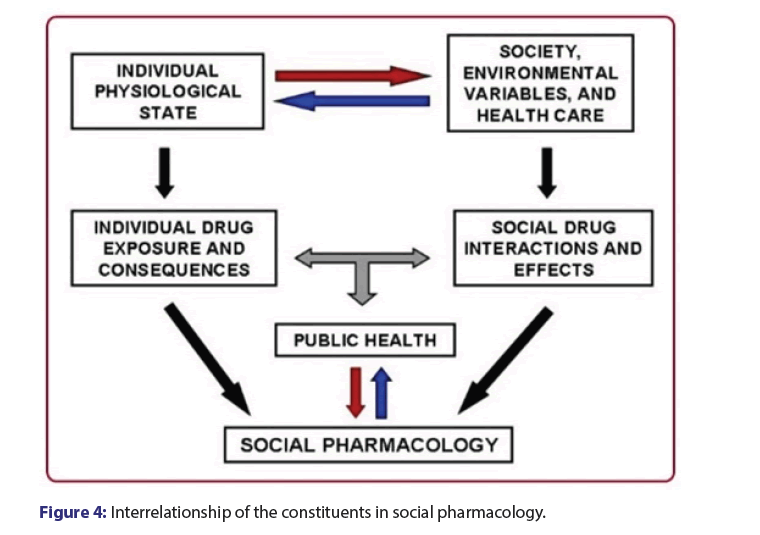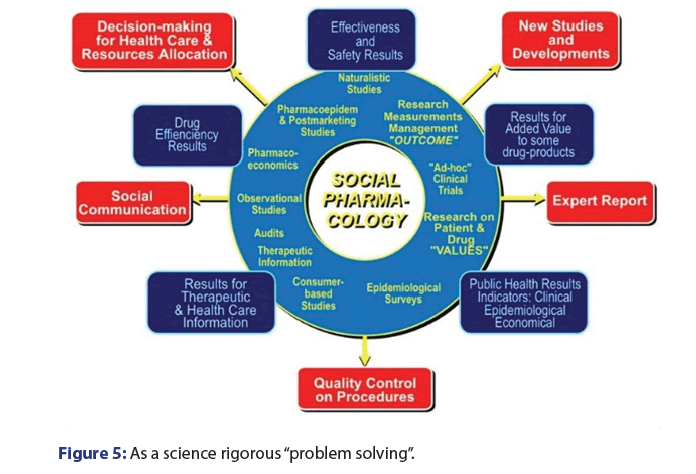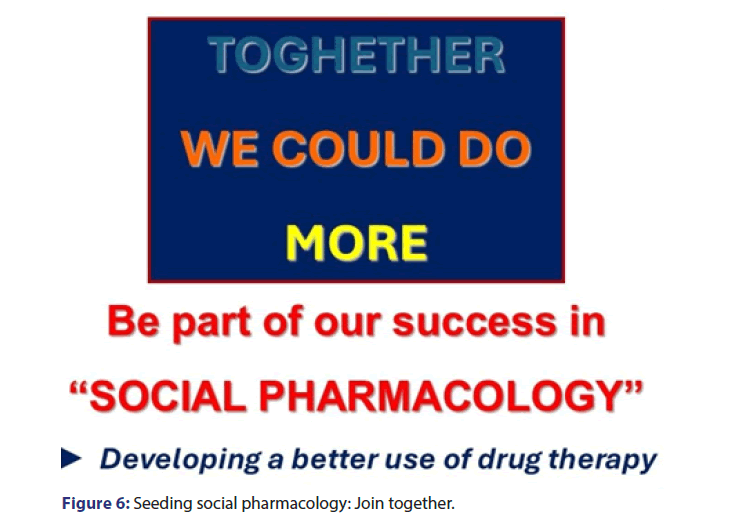45 of Years of Enabling and Pioneering Social Pharmacology
Received: 29-Aug-2024, Manuscript No. jbclinphar-24-146741; Editor assigned: 02-Sep-2024, Pre QC No. jbclinphar-24-146741 (PQ); Reviewed: 18-Sep-2024 QC No. jbclinphar-24-146741; Revised: 26-Sep-2024, Manuscript No. jbclinphar-24-146741 (R); Published: 04-Oct-2024
Citation: Alloza JL. 45 Years of Enabling and Pioneering Social Pharmacology. J Basic Clin Pharma. 2024,15(5):379-381.
This open-access article is distributed under the terms of the Creative Commons Attribution Non-Commercial License (CC BY-NC) (http://creativecommons.org/licenses/by-nc/4.0/), which permits reuse, distribution and reproduction of the article, provided that the original work is properly cited and the reuse is restricted to noncommercial purposes. For commercial reuse, contact reprints@jbclinpharm.org
Abstract
Social pharmacology is a discipline which implements better results of drug use. The discipline studies marketed drugs in their real “habitat”. A pluralistic society with a multidisciplinary structure. Health professionals, public health researchers, net researchers, as well academics and the communication mass media, are the common denominators which support its wide application. Its expansion takes into account the great value of new drugs, plus cultural and social changes.
Keywords
Social pharmacology; Drug development; Drug surveillance; Pharmacoepidemiology; Clinical trials; Postmarketing period; Pharmacogenomics
Description
Nearly 50 years ago it started pioneering the fundamentals of a new discipline entitled “Social pharmacology” (or Sociopharmacology), focusing on the values of drug utilization and their social consequences [1]. The diaspora of the discipline came from the 39th Annual Drug Information Association Meeting in 2003 in a session devoted to Social pharmacology [2]. The fundamentals of this discipline are described in a general reference [3]. The various components of Social pharmacology are derived from research aimed at results obtained from to different environments (Figure 1).
Figure 1: Contents of social pharmacology book 1985.
Overtime this discipline has expanded its horizon and become enriched by incorporating the contributions of physicians, pharmacists, nurses, biologists, drug epidemiologists, health economists, lawyers, regulators, insurance specialists and communications specialists (Figure 2) [4].
Figure 2: The focus of social pharmacology within environment of marketplace, major players and the weight of the patient differs among the scenarios.
The goal of this discipline is to attain knowledge about the use of drugs after marketing approval is obtained. The approval dossier contains only a tiny part of the knowledge that remains to be gathered as new drugs find their place in the market. The post-marketing period represents the widest vision of medication use when studied in an actual “life cycle” in a social habitat. This post-approval period is a new specific and aggressive environment where strict control of the drug development and distribution process is no longer in place through the operations and management control of the pharmaceutical industry and by government regulators.
The scope of social pharmacology is discussed in several publications [5-10]. The list of methodological approaches in Social pharmacology is extensive: Pharmacoepidemiological studies in drug surveillance, experimental and observational (‘naturalistic’), studies dose response variation, outcomes research, pharmacoeconomic studies, drugtoxicity evaluation, drug regulation evaluation, drug information evaluation (Figure 3) [11-17].
Figure 3: Mission of social pharmacology.
The merit of Social pharmacology consists of organizing the puzzle of the various contributing scientific topics and identifying the drug as the central part of the structure, achieving a sum of the efforts, and maximizing results of a new knowledge to be applied to the individual patient and society (Figure 4).
Figure 4: Interrelationship of the constituents in social pharmacology.
A recent report by Morgan describes how these applications of the scientific methodology of social pharmacology have now expanded widely to address many diverse issues associated with the post-approval utilization of drugs in the marketplace [18]. However, sometimes the value of the social pharmacology discipline and its supporter’s researchers, or authors may not be fully appreciated [19].
Major institutions with broad scientific horizons such as such as “Groupe Pharmacologie Sociale Toulouse” Service de Pharmacologie Clinique Faculte de Medicine have also recognized the benefit of applying this discipline.
Health education within universities is of special interest because the students represent the most influential sectors of the future society.
Progress with current events also moves the pharmaceutical industry towards the social interests of public health, and therefore, their activities fall within the framework of social pharmacology (Figure 5).
Figure 5: As a science rigorous “problem solving”.
There is an ancient saying that ‘nothing is as constant as change’. We are in a society of change, including globalization with its pluses and minuses. This means that any event can be quickly identified anywhere. This “constancy of change” can be our destiny, always with the desire to transform scientific curiosity into useful, societal applications (Figure 6) [20].
Figure 6: Seeding social pharmacology: Join together.
Conclusion
Social pharmacology is an interdisciplinary science that responds to new demands/alert mechanisms and encourages pharmacological research (real life). It interprets the real “life cycle” of the drug in its habitat and also expands the methodological approach and know how it works in the globalization process. Social pharmacology encourages an ongoing dialogue between researchers, generating projects and actions for the individual and the society under the support of public health. It promotes a proper and efficient use of drugs including “risk-benefit” analysis. It is a well-established discipline, included in the academic curriculum of medicine and pharmacy in some countries and a highly recommended method for solving drug problems. It has succeeded to impose/widespread itself all over the world. The pharmaceutical industry currently operates consistently with this discipline.
Acknowledgments
Louis lasagna, M.D, D.Sc. 1998 (2003†) tutor and mentor, “Dr. Alloza is, like these other physicians, a discipline in our efforts to improve the use of medicines in caring for the sick, and playing a leading role in the linkage between traditional clinical pharmacology and what might be termed “social pharmacology”.
This manuscript is dedicated to the of Louis Lasagna, M.D. Sci.D. who founded the first unit of clinical pharmacology in the world (Johns Hopkins University,1954). He was a tutor and mentor of many students including José-Luis Alloza M.D., Ph.D. and John J Schrogie M.D. John has contributed to the review and editing of this article.
Conflicts of Interest
The author declares that this updated article on “social pharmacology” has not any potential conflict of interest. The figures belong to the author.
References
- Alloza JL, del Valle M, Salvá-Miquel JA. Surveillance studies utilising epidemiological survey: Ambulatory patients older than 50 and younger than 16 years. 1980:3-9.
- Alghamdi F, Shakir M. The influence of Enterococcus faecalis as a dental root canal pathogen on endodontic treatment: A systematic review. Cureus. 2020;12(3).
[Crossref] [Google Scholar] [PubMed]
- Alloza JL. Clinical and social pharmacology: Postmarketing period. Revista de Medicina de la Universidad de Navarra. 1987:57.
- Alloza JL. Social pharmacology: Foundation for clinical pharmacy. Clin Pharmacol Biopharmaceut. 2013;2:3-100.
- Rucker TD. Drug-utilization review: Moving toward an effective and safe model. Society and medication: Conflicting signals for prescribers and patients. Lexington, MA: Lexington Books. 1983:25-51.
- Alloza JL. Family medicine, epidemiological drug research and social pharmacology. Medicina Clinica. 1984;82(3):124-129.
[Google Scholar] [PubMed]
- Lasagna L. Phase IV: The opportunity and the challenge. 1988;115-118.
- Venulet J. Towards social pharmacology. Clinical and Social Pharmacology. 1985:129-139.
- Johnson NE, Nash DB. The role of pharmacoeconomics in outcomes management. 1996:9-22.
- Mashford ML. Drug information and therapeutic guidelines: A second opinion before prescribing.1995:12-16.
- Montastruc JL. Social pharmacology: A new topic in clinical pharmacology. Therapie. 2002;57(5):420-426.
[Google Scholar] [PubMed]
- Mbongue TN, Sommet A, Pathak A, et al. “Medicamentation” of society, non-diseases and non-medications: A point of view from social pharmacology. Eur J Clin Pharmacol. 2005;61(4):309-313.
[Crossref] [Google Scholar] [PubMed]
- Alloza JL. Social pharmacology: Conceptual remarks. Drug Inf. J.2004;38:321-329.
- Alloza JL, Formigos JA. Information about prescription drugs in Spanish language websites on the internet is incomplete. Clin Pharmacol Ther 2007;81(1):67.
- Maiti R, Alloza JL. Social pharmacology: Expanding horizons. Indian J Pharmacol. 2014;46(3):246-250.
[Crossref] [Google Scholar] [PubMed]
- Alloza JL. Social pharmacology: A further step in public health. Open J. Soc. Sci.2014;6(1):8-15.
- Rai J, Kaushik S, Agrawal H, et al. Social pharmacology: A review of its implications and trends in covid-19 pandemic. Br J Pharm Res.2023;8(1):4145-4153.
- Morgan JH. Medicine, behavior and social values: Exploring the practical range of sociopharmacology. J Pharma Pharma Sci. 2016;1:1-4.
- Aldea-Perona AM, Beledo JF, Iniesta JF, et al. An account on the history of pharmacology in spain. Pharmacol Res. 2024;202:107104.
[Crossref] [Google Scholar] [PubMed]
- Lasagna L. Clinical pharmacology: Past, present and future. Rinsho yakuri/Japanese J Clin Pharm Therap. 1983;14(1):291-293.


